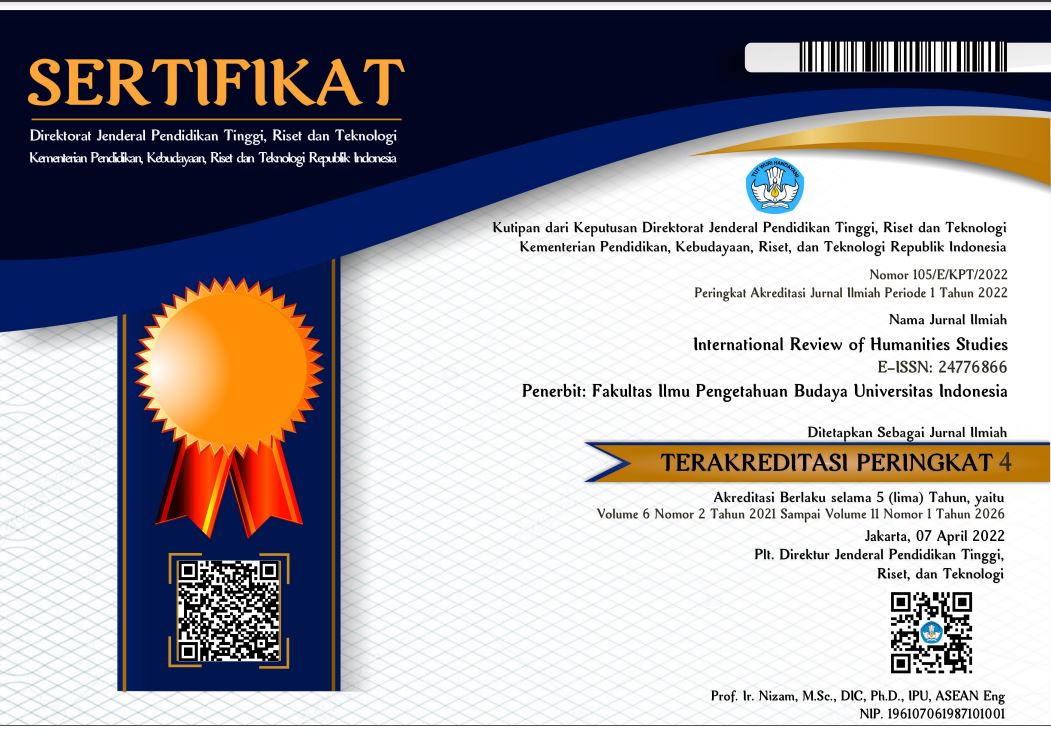International Review of Humanities Studies

Abstract
Riungan is an eating-together event involving the kampung community as a form of religious worship and gratefulness/gratitude to God. Through an ethnography approach, with in-depth interviews and a literature review as a method, this research explores the relationship between the practice of eating together and cultural identity in riungan as held by the Muslim Betawi of Kampung Pondok Pucung. The result of this research shows that riungan has become a space to representation of the cultural identity of the Betawi Pinggir (peripheral Betawi), particularly emphasizing their cultural and Islam heritage. Through the types of food brought and the communal eating practices, the cultural identity influenced by Sundanese and Javanese cultures is revealed. The practice of riungan at the mosque, musalla, and residents' homes underscores that this food practice is not only a form of worship but also a means to strengthen social relationships within the Muslim community, thereby reinforcing their cultural and religious identity.
References
Adi Susrawan, I. N., & Artika, I. W. (2023). Folklore of Megibung and Its
Digitalization as an Effort to Sustain the Balinese Tradition in the Globalization Era Article Info. Journal of Social Sciences and Humanities, 13(3), 212–224.
Agusta, A. A., Rukmi, W. I., Fairuzahira, S., & Purnamasari, W. D. (2020). Social
Interaction and the use of Space in the traditional activities of Kampung Naga. International Journal of Advanced Engineering Research and Science, 7(11), 80–92. https://doi.org/10.22161/ijaers.711.11
Agustina, I. H., & Pratiwi, N. P. (2019). Exploring the Spatial Arrangement of Local
Settlement. Proceedings of the Social and Humaniora Research Symposium (SoRes 2018). https://doi.org/10.2991/sores-18.2019.109
Barthes, R. (2012). Toward a Psychosociology of Contemporary Food Consumption. In C. Counihan & P. Van Esterik (Eds.), Food and Culture (3rd ed.). Routledge.
Bourdieu, P. (2012). Distinction: A Social Critique of the Judgement of Taste. In C.
Counihan & P. Van Esterik (Eds.), Food and Culture (3rd ed.). Routledge.
Castles, L. (1967). The Ethnic Profile of Djakarta. Indonesia, 3, 153–204.
https://doi.org/10.2307/3350726
Chee-Beng, T. (2015). Commensality and the Organization of Social Relations. In S. Kerner, C. Cynthia, & M. Warmind (Eds.), Commensality (pp. 13–30). Bloomsbury
Publishing Plc. https://doi.org/10.5040/9781474245326.ch-002
Dewantara, Y. F., Nurbaeti, & Arafah, W. (2023). Bubur Ase: Betawi Cultural Heritage
Food. Proceedings of the 4th International Conference on Tourism, Gastronomy, and Tourist Destination (TGDIC 2023), 100–107. https://doi.org/10.2991/978-94-6463-296-5_14
Dewiyanti, D., Martokusumo, W., Faisal, B., & Setia Budi, B. (2015). Sense of
Community in the Shape of Feeling Attached to the Salman Mosque-Bandung, Indonesia. Journal of Applied Environmental and Biological Sciences, 5(11), 45–52.
Erwantoro, H. (2014). ETNIS BETAWI: KAJIAN HISTORIS. Patanjala : Jurnal
Penelitian Sejarah Dan Budaya, 6(1), 1. https://doi.org/10.30959/patanjala.v6i1.180
Fadlan, M. N., Sudjarwo, & Sinaga, R. M. (2020). Social action in Suroan tradition in
Javanese Society. Journal of Humanities and Social Sciences, 17, 133–148. https://api.semanticscholar.org/CorpusID:234739118
Ferdous, H. S., Ploderer, B., Davis, H., Vetere, F., & O’hara, K. (2016). Commensality
and the Social Use of Technology during Family Mealtime. ACM Transactions on Computer-Human Interaction, 23(6), 1–26. https://doi.org/10.1145/2994146
Giacoman, C. (2016). The dimensions and role of commensality: A theoretical model
drawn from the significance of communal eating among adults in Santiago, Chile. Appetite, 107, 460–470. https://doi.org/10.1016/j.appet.2016.08.116
Hall, S. (1997). Representation: Cultural Representations and Signifying Practices.
SAGE Publications & Open University.
Hall, S. (2021). Cultural Identity and Diaspora [1990]. In P. Gilroy & R. W. Gilmore
(Eds.), Selected Writings on Race and Difference (pp. 257–271). Duke University Press. https://doi.org/10.2307/j.ctv1hhj1b9.17
Johnson, J. M., & Rowlands, T. (2012). The Interpersonal Dynamics of In-Depth
Interviewing (J. F. Gubrium, J. A. Holstein, A. B. Marvasti, & K. D. McKinney, Eds.; 2nd ed., pp. 99–114). SAGE Publications, Incorporated.
Knörr, J. (2014). Creole Identity in Postcolonial Indonesia (1st ed.). Berghahn Books.
http://www.jstor.org/stable/j.ctt9qcwb1
Lévi-Strauss, C. (2012). The Culinary Triangle. In C. Counihan & P. Van Esterik
(Eds.), Food and Culture (3rd ed.). Routledge.
Nanuru, R. F. (2019). Orom Sasadu: Hakikat dan Maknanya Bagi Masyarakat Suku
Sahu Di Halmahera Barat, Maluku Utara. Jurnal Filsafat, 29(1), 66–101. https://doi.org/10.22146/jf.41641
Perbawasari, S., Anisa, R., Sjoraida, D., & Subekti, P. (2022). The Tradition and
Communication Culture of the Cireundeu Traditional Village Community. Proceedings of the First International Conference on Literature Innovation in Chinese Language, LIONG 2021, 19-20 October 2021, Purwokerto, Indonesia. https://doi.org/10.4108/eai.19-10-2021.2316734
Permanasari, E., Hendola, F., Tarigan, S., Tafridj, I., & Aurora, F. (2024). Urban
expansion in South Tangerang: Analyzing Bintaro Jaya as a private city. Cities, 144, 104665. https://doi.org/https://doi.org/10.1016/j.cities.2023.104665
Rianti, A., Novenia, A. E., Christopher, A., Lestari, D., & Parassih, E. K. (2018).
Ketupat as traditional food of Indonesian culture. Journal of Ethnic Foods, 5(1), 4–9. https://doi.org/https://doi.org/10.1016/j.jef.2018.01.001
Sari, D. C., & Munandar, A. (2020). Characteristic Assessment and Cultural Landscape
Conservation of Urug Indigenous Village. IOP Conference Series: Earth and Environmental Science, 501(1), 012045. https://doi.org/10.1088/1755-1315/501/1/012045
Storey, J. (2015). Cultural Theory and Popular Culture: An Introduction (7th ed.).
Routledge. https://doi.org/10.4324/9781315744148
Suswandari, S. (2017). Local History of Jakarta and MulticulturalAttitude (Historical
Local Study of Betawi Ethnic). JETL (Journal Of Education, Teaching and Learning), 2(1), 93. https://doi.org/10.26737/jetl.v2i1.142
Tuten, J. H. (2019). Commensality: The Essential Concept of Food Studies. Juniata
Voices, 20, 51–65.
Winarni, R. W., Pratama, D., Nurfarkhana, A., Listya, A., & Hidayati, A. N. (2020).
Cultural Identity Construction in Betawi Fashion System of Kerak Telor Sellers.
Proceedings of the 1st International Conference on Folklore, Language, Education and Exhibition (ICOFLEX 2019). https://doi.org/10.2991/assehr.k.201230.008
Yuliastuti, N., Sukmawati, A. M., & Purwoningsih, P. (2018). UTILIZATION OF
SOCIAL FACILITIES TO REINFORCE SOCIAL INTERACTION IN FORMAL HOUSING. International Journal of Architectural Research: ArchNet-IJAR, 12(1), 134. https://doi.org/10.26687/archnet-ijar.v12i1.1295
Recommended Citation
Julianto, Gregorio Surya Abdi and Bachrioktora, Yudi
(2024)
"RIUNGAN: REPRESENTATION OF MUSLIM BETAWI PINGGIR THROUGH THE PRACTICE OF EATING TOGETHER (A CASE STUDY OF KAMPUNG PONDOK PUCUNG, PONDOK AREN, SOUTH TANGERANG),"
International Review of Humanities Studies: Vol. 9:
No.
2, Article 4.
DOI: 10.7454/irhs.v9i2.1305
Available at:
https://scholarhub.ui.ac.id/irhs/vol9/iss2/4
Included in
Anthropology Commons, Art and Design Commons, Creative Writing Commons, Cultural Heritage Law Commons, Education Law Commons, Film and Media Studies Commons, History Commons, Intellectual Property Law Commons, International and Area Studies Commons, Legal Writing and Research Commons, Linguistics Commons, Museum Studies Commons, Philosophy Commons, Urban Studies and Planning Commons



